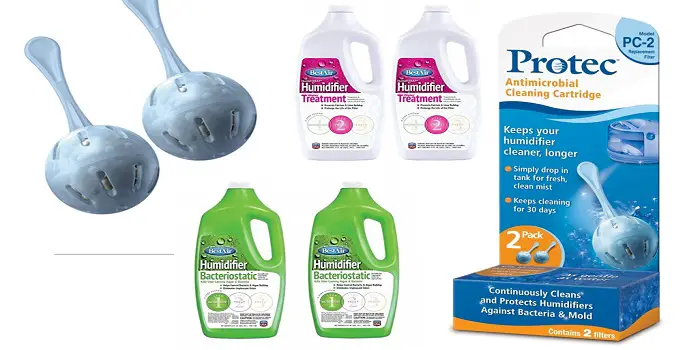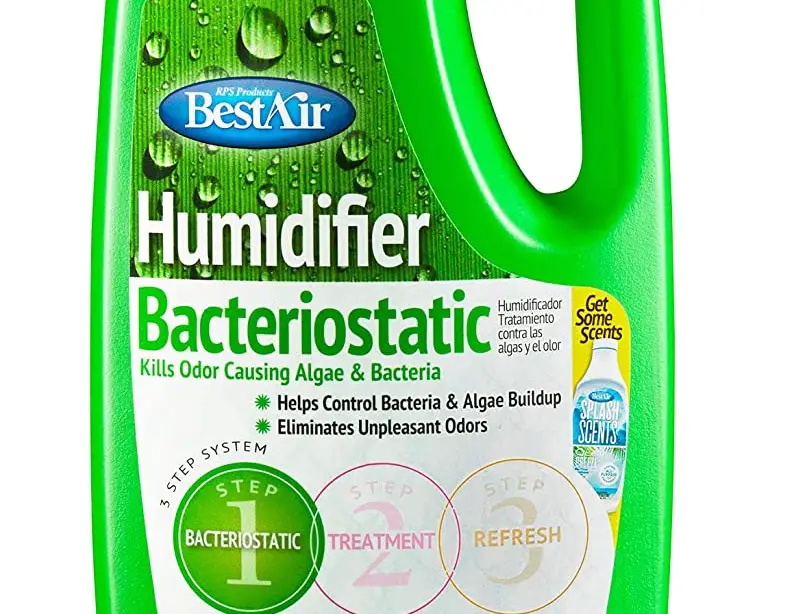
Ultrasonic room humidifiers need regular cleaning and maintenance so that you enjoy their great benefits day after day. The good thing is you can do all the cleaning yourself without any professional help once or twice a week, depending on the usage.
Additionally, additives such as white vinegar can be safely put in your humidifier machine to prevent the growth of molds, algae, bacteria, and foul smells.
Many people recommend products like tea tree essential oils, hydrogen peroxide, Lysol, etc., for preventing molds. But you should only use them after checking with the humidifier manufacturer if they allow adding such products to their unit.
Why does Mold Form in Humidifier?
Mold is a kind of harmful fungus that typically grows in wet and enclosed environments. You will usually see them thriving in the form of green, brown, white, or black patches near wet or moist surfaces.
Since your humidifier tank is an ideal place that provides them with the needed moist enclosed environment, they grow there and can thrive for a long time unless cleaned or prevented.
The bad part is that they can multiply faster and can spread into the air all over your house and rooms to cause various body ailments like asthma, bronchitis, and even humidifier lung (HL).
How to Keep Your Humidifier Mold-Free?
Let’s face it—your humidifier is supposed to help you breathe easier, not turn into a microscopic swamp monster factory loaded with molds and algae.
Luckily, there are simple ways to keep your humidifier clean, mold-free, and doing its actual job: keeping you comfy and healthy.
Ready to kick mold to the curb? Let’s dive into these five game-changing tips (with just enough wit to make cleaning sound slightly less boring).
1. Use Distilled Water (Not Tap Water)
You might be tempted to use plain old tap water. It’s easy. It’s convenient. But it’s also full of minerals and impurities that mold absolutely adores. Distilled water is clean, pure, and boring in all the right ways.
No minerals = no buildup = no mold buffet. It’s the hydration your humidifier deserves.
2. Don’t Let Water Sit for More Than 24 Hours
Water sitting in your humidifier for more than a day is like leaving milk out in the sun—something funky is definitely brewing.
Mold loves stagnant water; it’s basically a spa day for spores. So if you’re not using your humidifier every day, drain that tank like a responsible adult. A fresh fill means a fresh start, every time.
3. Pair Your Humidifier with an Air Purifier
Your humidifier should have an air purifier. While the humidifier moisturizes the air, the purifier captures airborne mold spores before they even think about colonizing your machine.
Together, they’re like a tag team for air quality domination—keeping your space fresh, balanced, and mold-free.
4. Use a Humidifier with an Antimicrobial Filter
Think of an antimicrobial filter as the bouncer at your humidifier’s front door. Mold tries to enter, but the filter’s like, “Not today, fungus.” These clever filters are designed to stop bacteria, mold, and other nasties from taking over.
So, instead of hosting a biohazard rave in your living room, you get clean, breathable air. Invest in a humidifier with this feature and let the filter do the dirty work, so you don’t have to.
5. Empty and Clean Regularly
Nobody likes cleaning, but mold loves it when you don’t. Even if you’re using filters and good water, gunk builds up—because water and warmth are mold’s favorite love language.
So give your humidifier some TLC at least once a week. A gentle scrub with white vinegar or hydrogen peroxide works wonders and keeps your device from turning into a science experiment gone wrong.
3 Things You Can Put in Humidifier to Prevent Mold
People often ask me why their new cool-mist humidifier smells terrible.
If it’s new, it can be due to the packaging smell or the plastic smell. This generally goes away by simply rinsing your humidifier tank and housing it with clean, warm water.
If your cool mist humidifier smells terrible after a few usages, it can be for various reasons. Some of them may include:
- Stagnant water in the humidifier
- Unsightly bacteria, mold, & algae growth
- Growth of odor-causing bacteria due to untreated humidifier surfaces
If you are worried about all these issues, humidifier tank cleaners come to your rescue. Below, we are discussing some of the best options for your humidifier…
1- Demineralized Water
Filling your humidifier tank simply with regular tap water can bring many issues for you. If possible, you should add distilled or demineralized water – as it contains lesser mineral contents.
Using filtered or distilled water is best for humidifiers as it helps prevent white mineral dust from expelling out into your indoors, which is seen when you use regular tap water.
White dust, when formed and expelled regularly, can prove harmful for your lungs (as you will most likely inhale some) as well as expensive furniture.
2- Protec Humidifier Cleaner
Protect humidifier cleaning fish (available on Amazon) is one of the most beautiful products I love using.
Humidifier tank cleaning cartridges like Protec humidifier cleaning balls can also be used for enjoying safe and nontoxic humid air.
Compatible with most brands and humidifier models, this offers easier humidifier tank cleaning in an automated way. These are also effective enough to reduce up to 99% of mold and algae growth and bacteria that cause an odor in a humidifier device.
3- Natural White Distilled Vinegar
White distilled vinegar can be added to the water while you plan to operate the device mold-free. You just need to add vinegar to the humidifier water and run it for half an hour before operating it.
This homemade humidifier water treatment acts as a natural disinfectant, sterilizer as well as deodorizer that helps in minimizing the mineral build-up and disinfection.
Especially for people who are suffering from any kind of respiratory issues, this can prove much helpful in cleaning a moldy humidifier.
Follow the below steps, and you are good to go…
- Discard the left-out water in your unit after the use
- When using again, pour freshwater (demineralized or distilled) into the tank of the unit
- Now add about 1/4 cup of white distilled vinegar into the water present in your humidifier unit
What is the Pink or Yellow Stuff in My Misting Humidifier?
The pink stuff in or around your room humidifier is mostly a sign of bacterial, mold, or fungus growth. But the thing to remember is that it’s not always the pink substance that builds up on your room humidifier or a CPAP humidifier.
Sometimes you can even see it as yellow residual stuff, or it can be an orange slime.
- Aureobasidium pullulans – is the pink mold in a humidifier
- Bacteria Serratia marcescens – is the pink resides or mineral deposits in humidifiers
- Fusarium – is the pink fungus build-up in and around the humidifier
Other than the above, there are molds such as Aspergillus flavus, Epicoccum nigrum, or Geomyces pannorum that can be seen as yellow particles or orange mineral deposits in your humidifier.
Also, there are molds such as Cladosporium, Ulocladium, and Taeoniella, that grow in humidifiers to look like brown sediment or dirt particles.
All these pink, yellow, brown, or orange residues can pose various health risks such as allergies, infections, and in some cases, severe respiratory illnesses.
If you have a humidifier in your room, it’s therefore essential to clean it regularly to prevent the growth of these contaminants.
Does BestAir Humidifier Antibacterial Treatment Work – Is it Worth Buying?
In general, the bacteriostatic treatment agents for humidifiers are not meant for
cleaning the units. These are somewhat helpful in reducing the cleaning frequencies significantly.
By using a good bacteriostatic solution (such as BestAir humidifier treatment), you can keep your unit clean and hence can expect to prolong the life of the device and its wick/filter.
The humidifier antibacterial solution like BestAir 3BT reduces the growth rate of bacteria, viruses, and algae that grows inside your unit’s water tank.
Remember, these agents do not stop the mold formation completely. So, to get rid of the mold and odor, you still need to clean your ultrasonic humidifier unit once in a while (but not too frequently).
Are There Any Side Effects of Using Bestair 3BT?
Like with using any other chemicals, these bacteriostatic treatment solutions can also be toxic in nature.
Depending on the concentration you may be using, it can emit a bad smell and harmful chemicals while dispersing the mist. It is therefore essential that you handle them carefully and add the right amount to the water inside the tank.
Tips for using the BestAir humidifier bacteriostatic safely
The BestAir 3BT treatment can do a great job if you use them cautiously.
In many cases, the life of the filters doubled (and even tripled) after the users tried it on their humidifier’s water tank. The thing you need to take care of is the amount of solution you use for the treatment.
BestAir usually recommends adding a cap full of solution for each gallon of water
inside the tank. However, based on my personal experiences and of some consumers, I recommend adding 5ml-10ml of it per gallon of water in the tank.
As a precaution, it is good not to use the solution before going to bed. Either add it in the daytime or about 2-3 hours before you sleep. This will avoid any chemical emitting and disturbing your sleep.
So, is it worth buying?
Although using these solutions can be toxic for families, using them with all the care can provide you with good overall benefits.
After all, with an overall rating of 4.4 out of 5 stars and more than a thousand reviews from the consumers who purchased the product on Amazon, the product cannot just be worthless.
If you decide to buy and use it, make sure that you follow the above guidelines and stay safe.
Meen Smith is a nurse by profession who loves writing online, spending time with her family and caring for the elderly. She has already worked as an associate editor on various moms, babies, home appliances, kitchen, and healthy living blogs. In her spare time, she also enjoys drawing, reading/writing kindle eBooks and improving her skills a bit.

